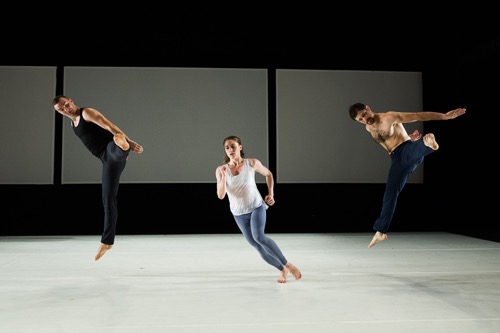We’re pleased to offer you “Flash Feldenkrais for Dancers” — by Nancy Wozny. Nancy is the Somatics expert on our Dance Wellness Panel — she wrote the article introducing Somatic work, and why it matters for dancers, “A Somatic Update for Dancers” in August of 2014. Nancy is a Feldenkrais practitioner herself, and is sharing her expertise with you in this series of “Flash Feldenkrais” postings — here is the first one. Try it – I think you will like it. Enjoy! – Jan

Note: This is the first in a series of Feldenkrais Awareness Through Movement Lessons that have been streamlined for dancers.
by Nancy Wozny
Watching Liz Gerring’s dancers in glacier this summer at Jacob’s Pillow navigate their way through a glorious feast of highly nuanced movement reminded me of how somatically rich some contemporary dancers’ lives are these days. Because Gerring’s vocabulary is so mind bogglingly detailed, her dancers are neurally nourished with novelty on a daily basis. Gerring’s dancers also move as if each step is a question, embracing an exploratory process, so that each movement feels like an act of discovery. The sheer abundance of specificity not only makes for compelling choreography, but has an added benefit to the dancers, and possibly the viewers as well. Just watching these deft movers made me feel as if I was getting a month-long Feldenkrais retreat thanks to those handy mirror neurons at work.
Sometimes, we forget just how diverse a dancer’s life is when considering the role of Somatics for today’s dancer. Somatics, defined by philosopher Thomas Hanna, is the study of the body as a lived experience. In my first piece for 4dancers, A Somatics Update, I outlined the characteristics of the field, which include cultivating an accurate sense of awareness, the use of non-habitual movement, resting between actions and attention to our habits, to name a few. The Feldenkrais Method, one of many somatic practices, is particularly useful for performing artists, especially dancers because of their complicated movement lives, which includes both repetition and novelty.
Contemporary choreographers and educators regularly look to change the status quo in what they are asking dancers to do. The movement in today’s dance classes and choreography is considerably more varied than it was say 20 years ago. What does all this have to do with Somatics?
You are busy, and all of us dance health folk are always trying to make you busier. Do this! Do that! The list of what a dancer needs to do besides daily technique class to stay healthy seems to grow each year.
I understand the demands of today’s dancer enough to know that anything can be streamlined to fit an artist’s schedule, even the prolific work of Moshe Feldenkrais, who created over 3,000 brilliant Awareness Through Movement lessons. And trust me, each one is a gem. Although it’s always beneficial to do longer and more complicated lessons, especially when you are in recovery mode, it’s possible to receive a benefit from shorter lessons.
Feldenkrais could very well be the father of cross training as well as somatics, as he addressed expanding our habits head on by introducing the role of novelty in movement as a neural refresher.
We also need to keep in mind that Feldenkrais Method and dance share some of the same domain, which includes inventive movement. The average dancer has no shortage of novelty in their lives, as they regularly meet the demands of today’s choreographers who tirelessly look for new ways to put the human body into action.
Maintenance mode doesn’t quite need the same time commitment, especially when you are getting a good amount of somatic diversity in your daily classes and rehearsals. However, a dancer’s time and energy budget is tight, so perhaps a need-to-know approach may be more doable when it comes to maintaining your somatic health.
With all of this in mind, I offer Flash Feldenkrais for the Busy Dancer, streamlined lessons that address common conditions in a dancers’ working life, which sometimes involves an abundance of novelty. That can be discombobulating in its own right. Sometimes, we need to scale back, look to more central organizations, and simply calm the whole system down. And because it’s Feldenkrais, a tiny bit of novelty pops in at the end because we always need a little post Feldenkrais play time.
Flash Feldenkrais Lesson #1: Returning to Neutral
When to do this lesson: When you have been doing a lot of performing or traveling, or both at the same time. Anytime something has thrown you off from your center, this lesson will help reel you in. I find it to be a somatic palate cleanser, and a “returning to your baseline” lesson.
Why do this lesson: You will find a wonderful ease in your limbs afterward. It’s the Feldenkrais equivalent of straightening out your holiday lights when they get all in a jumble.
What do you need to do this lesson: A soft mat or blanket and 15-20 uninterrupted minutes in a quiet room.
Remember: Rest between each step and before you fatigue. Do each instruction just a few times. Make the movement as easy as possible.
Lie on your back with your legs long and your arms by your side. Sense your contact against the ground. Bring your right arm up so that your fingers point to the ceiling and your palm faces your midline. Notice the effort it takes to do this movement.
Bend up your knees and bring your feet to standing. Bring your right arm up again and move your right arm slightly toward and away from your midline. Notice the “sweet spot” when you pass through neutral.
Bring your right arm up again and move it slightly toward your head and then toward your feet. Notice when you pass through neutral.
Bring your right arm up again and move it toward the midline and away, then toward your head, then your feet, always returning to neutral between each movement.
Repeat steps 1-5 with the left arm.
Repeat steps 1-5 steps with both arms at once.
Repeat steps 1-5 with the right leg in the air.
Repeat steps 1-5 with the left leg in the air.
Bring all limbs into the air and spend some time improvising. Play with the limbs moving toward and away from each other in various configurations. This is where the imagination can slip in while you find some new and fun ways of moving your limbs in space.
Rest on your back again. Lift your right arm into the air and notice how easy it is now. Come to sitting, then standing. Walk around and notice your sense of ease and grace.
NEXT UP: Stay tuned for the second installation of Flash Feldenkrais for the Busy Dancer, which will focus on organizing oneself for a shift and cleansing the kinesthetic palate.
Nancy Wozny is editor in chief of Arts + Culture Texas, reviews editor at Dance Source Houston and a contributor to Pointe Magazine, Dance Teacher and Dance Magazine, where she is also an contributing editor. She has taught and written about Feldenkrais and somatics in dance for two decades.






Nice! I was surprised recently when a patient came into our chiro office with a recommendation from his MD to study Feldenkrais. The d.c asked me “have you ever heard of this?” Oh yes…